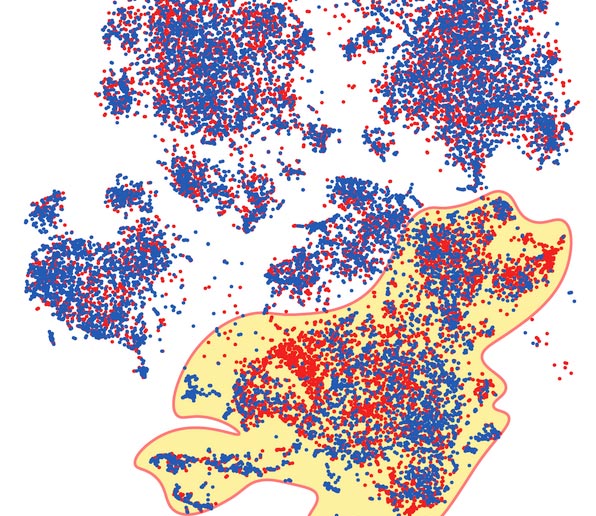Cellular ‘waste product’ rejuvenates cancer-fighting immune cells

UT Southwestern Simmons Cancer Center found that lactate, a metabolic byproduct produced by cells during strenuous exercise, can rejuvenate immune cells that fight cancer. The image shows single cell transcriptome analysis enrichment of tumor infiltrating T cells, the red dots, after lactate treatment.
Credit: UT Southwestern Medical Center
Lactate, a metabolic byproduct produced during exercise, could augment current immunotherapies.
A new study by UT Southwestern’s Simmons Cancer Center scientists suggests that lactate, a metabolic byproduct produced by cells during strenuous exercise, can rejuvenate immune cells that fight cancer. The finding, published in Nature Communications, could eventually be used to develop new strategies to augment the anti-tumor effect of cancer immunotherapies, the study authors said.
“The lactate that we usually think of as a waste product appears to have a previously unrecognized role in fighting cancer,” said Jinming Gao, Ph.D., Professor of Cell Biology, Otolaryngology – Head and Neck Surgery, and Pharmacology, and member of the Harold C. Simmons Comprehensive Cancer Center. Dr. Gao co-led the study with fellow Simmons Cancer Center members Baran Sumer, M.D., Professor of Otolaryngology – Head and Neck Surgery, and Bo Li, Ph.D., Assistant Professor of Immunology and in the Lyda Hill Department of Bioinformatics.
Lactate is commonly used in Ringer’s solution, administered intravenously to replace fluids after blood loss due to trauma, surgery, or severe burns or to treat a condition called metabolic acidosis. While lactic acid (lactate with an additional proton) has been associated with cancer growth and immune suppression, the effects of lactate on cancer and immunity have been unclear.
To investigate this question, Dr. Gao and his colleagues gave lactate injections to mice with colon cancer or melanoma; other tumor-bearing mice received glucose injections. While glucose had little effect, tumor growth was significantly reduced in mice treated with lactate. When the researchers tried the same experiment in mice genetically engineered to lack T cells, this anti-tumor benefit was blocked, suggesting that lactate appeared to be exerting its effects through this immune cell population.
Administering lactate alone didn’t completely eliminate the tumors. But when the researchers added a commonly used immune checkpoint inhibitor – a type of cancer immunotherapy that releases the brakes that prevent T cells from fighting malignancies – about half the mice became completely tumor-free. Lactate also significantly improved the effects of a cancer-fighting vaccine and improved the anti-cancer response of cultured T cells that were injected into tumor-bearing mice.
Further single-cell RNA sequencing analysis showed that more T cells infiltrated the tumors of the lactate-treated mice. Compared to animals that didn’t receive this treatment, T cells from the mice that received lactate expressed more genes associated with stem-like T cells and a smaller number of genes associated with exhaustion markers, making them more fit to effectively fight cancer.
Dr. Gao said the data suggest that lactate could be used to supplement existing immunotherapies, such as immune checkpoint inhibitors, cancer vaccines, and CAR-T cell therapy – a cancer treatment in which T cells engineered to fight specific tumor types are expanded in the laboratory and then injected into patients. It also suggests that exercise, which naturally raises lactate levels, may be protective against cancer or may augment the immune system to fight cancer as well. Dr. Gao and his colleagues plan to investigate these topics in future studies.
Dr. Gao holds the Elaine Dewey Sammons Distinguished Chair in Cancer Research, in Honor of Eugene P. Frenkel, M.D. Dr. Sumer holds the T.C. Lupton Family Professorship in Patient Care in Honor of Dr. John Dowling McConnell and Dr. David Andrew Pistenmaa. Dr. Fu holds the Mary Nell and Ralph B. Rogers Professorship in Immunology. Dr. Sumer is also a member of the Peter O’Donnell Jr. Brain Institute.
Other UTSW researchers who contributed to this study include Qiang Feng, Zhida Liu, Xuexin Yu, Tongyi Huang, Jiahui Chen, Jian Wang, Jonathan Wilhelm, Suxin Li, Jiwon Song, Wei Li, and Zhichen Sun.
This research was funded by the National Institutes of Health (R01CA216839 and U01CA218422) and the Mendelson-Young Endowment in Cancer Therapeutics.
About UT Southwestern Medical Center
UT Southwestern, one of the nation’s premier academic medical centers, integrates pioneering biomedical research with exceptional clinical care and education. The institution’s faculty has received six Nobel Prizes, and includes 26 members of the National Academy of Sciences, 17 members of the National Academy of Medicine, and 14 Howard Hughes Medical Institute Investigators. The full-time faculty of more than 2,900 is responsible for groundbreaking medical advances and is committed to translating science-driven research quickly to new clinical treatments. UT Southwestern physicians provide care in more than 80 specialties to more than 100,000 hospitalized patients, more than 360,000 emergency room cases, and oversee nearly 4 million outpatient visits a year.
Media Contact
News Team
UT Southwestern Medical Center
news@utsouthwestern.edu
Office: 214-648-3404
All latest news from the category: Health and Medicine
This subject area encompasses research and studies in the field of human medicine.
Among the wide-ranging list of topics covered here are anesthesiology, anatomy, surgery, human genetics, hygiene and environmental medicine, internal medicine, neurology, pharmacology, physiology, urology and dental medicine.
Newest articles

Superradiant atoms could push the boundaries of how precisely time can be measured
Superradiant atoms can help us measure time more precisely than ever. In a new study, researchers from the University of Copenhagen present a new method for measuring the time interval,…

Ion thermoelectric conversion devices for near room temperature
The electrode sheet of the thermoelectric device consists of ionic hydrogel, which is sandwiched between the electrodes to form, and the Prussian blue on the electrode undergoes a redox reaction…

Zap Energy achieves 37-million-degree temperatures in a compact device
New publication reports record electron temperatures for a small-scale, sheared-flow-stabilized Z-pinch fusion device. In the nine decades since humans first produced fusion reactions, only a few fusion technologies have demonstrated…





















